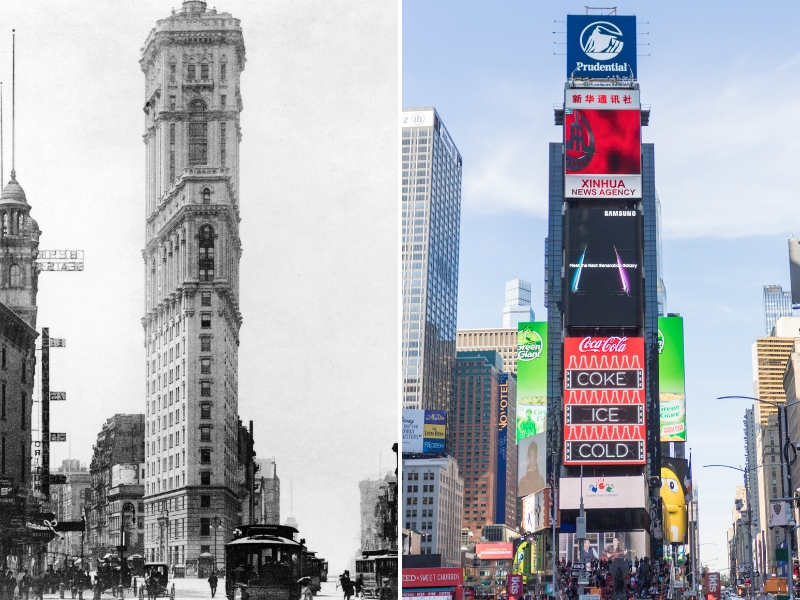- Aside from the few that have been restored, many monuments that have been standing for hundreds of years don’t look anything like they did when they were first built.
- Landmarks like the Colosseum or the Parthenon have suffered from neglect and natural disasters.
- From Times Square to the Great Sphinx of Giza, here are the landmarks that no longer look the way they did when they were first built.
- Visit Insider’s homepage for more stories.
Many structures around the world have been standing for hundreds of years. Save for a select few that have been meticulously cared for or restored, most look very different now than they did the day they were completed.
Here are some landmarks that you might not recognize if you traveled back in time.
Before Madison Square Garden, there was Penn Station.

Completed in 1910 and once a stunning piece of Roman-inspired architecture, the original Pennsylvania Station in New York City was largely demolished in 1963 to make room for Pennsylvania Plaza and Madison Square Garden.
New York’s original Penn Station was torn down in 1963 and replaced by Madison Square Garden.

Some of the old statues, walls, ironwork, and staircases still exist, but you have to know where to look.
Pompeii was once believed to be a flourishing Roman city.

The ancient city was established around the 6th or 7th century BC and was once considered a flourishing spot for Rome's elite. The town was made up of townspeople who frequented the shops and taverns, and who gathered in the arena, which sat 20,000 people.
The eruption of Mount Vesuvius buried the ancient city under volcanic ash.

Naturally, there would have been changes over time, but the eruption of Mount Vesuvius covered the city in ash. A massive earthquake leveled buildings 16 years before surges of hot volcanic material swept across the city in 79 AD. Thousands were killed and the city was left in ruins.
The ancient city is now a popular historical site for archaeologists curious about Roman life.
Stonehenge was constructed in phases, and historians believe there used to be more to the prehistoric monument.

The purpose of the giant stone monument in Wiltshire, England, has been debated for centuries, but what most historians are sure of is that there used to be more to the famous prehistoric site.
It is believed that the first major construction of Stonehenge occurred around 3000 BC and consisted of a circular ditch with an inner and outer bank. The stones were set up in the center of the monument around 2500 BC.
Throughout the years, the stones were believed to have been rearranged.

Since the construction of Stonehenge first began, stones have fallen and parts of the monument have been altered, moved, or have even disappeared.
Over recent years, the UNESCO World Heritage site has also undergone several restorations to prevent collapse.
The Statue of Liberty is made of copper, so it was originally bronze in appearance.

The robed statue with her spiked crown, raised torch, and big stone tablet stands just over 305 feet tall and was designed by French sculptor Frédéric Auguste Bartholdi. It has an iron frame that is covered in an estimated 200,000 pounds of copper.
But today, the statue is recognized by its green color.

When France gifted the Statue of Liberty to the United States in the late 19th century, it looked more like a dull brown penny. At some point around 1900, that copper went through an oxidation process that gave the metal its iconic shade of blue-green.
The Colossus of Rhodes was a massive statue that once stood over the Greek city.

One of the Seven Wonders of the Ancient World, the Colossus of Rhodes was a bronze and iron statue of the sun-god Helios, which stood over 100 feet tall in the city of Rhodes, on the Greek island of the same name.
Its exact appearance remains a mystery, but many artists have imagined what it may have looked like.
An earthquake hit Rhodes around 226 BC and caused the statue to collapse.

An earthquake toppled the giant around 225 or 226 BC. Its broken body remained in place for hundreds of years before being scrapped around 654 AD.
No one knows for sure what the statue looked like or where exactly it stood because there is no trace of it today, but tourists still go to the site where it may have been to take photos and to use their imagination.
Read more: A YouTuber who filmed himself visiting the 7 Wonders of the World in 7 days told us how he did it
The Berlin Wall once stretched 96 miles long.

Constructed by the Communist government to divide East and West Berlin in 1961, the controversial and globally contested Berlin Wall stood 12 feet tall and stretched 96 miles long (27 of which divided Berlin). There were 302 guard towers at various points and barbed wire along the top to stop people from crossing over.
Today, only small sections of the wall are left standing.

The wall finally began to fall nearly three decades later in 1989. Random sections of the wall still exist in and around the city, as do "Berliner Mauer 1961-1989" plaques in the pavement.
The Mausoleum at Halicarnassus was a 140-foot-tall tomb and one of the Seven Wonders of the Ancient World.

Formerly a 140-foot-tall tomb built for Mausolus, the ruler of Caria, and his queen Artemisia, the Mausoleum at Halicarnassus (or Halikarnassos) was one of the Seven Wonders of the Ancient World.
There are written accounts of what the structure looked like, including a book written by the architects, but historians have had to take a few artistic liberties when it comes to visuals.
The structure was ultimately destroyed by a series of earthquakes.

In present-day Turkey, pillar bases and rubble are all that remain at the site because earthquakes leveled the structure between the 11th and 15th centuries.
Various marble sculptures and other artifacts have been recovered and preserved by art institutions.
Times Square wasn't always home to large crowds of tourists.

Originally called Long Acre Square until 1904, New York City's Times Square has undergone a lot of changes over the past century.
Adolph S. Ochs, the owner and publisher of The New York Times until 1935, selected Times Square for the construction of the city's second-largest building at the time (Times Tower), which opened in January 1905. Over the years, prominent theaters and restaurants began moving from downtown Manhattan to join Och's building in Times Square.
Things started to decline after the Great Depression, and soon only the "lower forms of entertainment" survived, but throughout the good and bad times, the large open area was a place for large crowds to congregate, either in bread lines, for parades, or for annual New Year's Eve celebrations.
Today, skyscrapers covered in flashing screens light up the tourist hotspot.

Today, painted signs and neon have been largely replaced by enormous television screens, more skyscrapers have been erected, and more people from around the world flood into the limited space every day to get a glimpse at the tourist hotspot.
Read more: THEN AND NOW: How famous New York City landmarks have changed over the years
Traces of paint found on the Great Sphinx of Giza suggest it used to be more colorful than it is today.

The Great Sphinx of Giza is a giant limestone statue in Egypt that depicts a mythical creature with the body of a lion and the head of a person. It is one of the oldest and largest monuments in human history, but no one knows for sure who built it or why it is missing a key facial feature.
Paint residue found near one ear also suggests the Sphinx was not always tan, but instead, covered in color.
Over the centuries, the statue has been impacted by weathering and vandalism.

The body of the Sphinx has eroded over time, despite efforts to restore the landmark, and parts of the face are missing. The beard of the Sphinx was displayed in the British Museum.
The Roman Colosseum featured seating for more than 50,000 people.

The Roman Colosseum, also known as the Flavian Amphitheatre, was commissioned by Emperor Vespasian around 70 AD as a gift for the people. With seating accommodations for over 50,000 people, the structure was used for centuries as a venue for entertainment, including gladiator matches and wild animal fights.
Those events were eventually phased out, and the Colosseum became a source of building materials.
Nearly two-thirds of the original Colosseum was destroyed by weather, neglect, and time.

Weather, natural disasters, time, and neglect turned the once-grand structure into a crumbling relic, destroying nearly two-thirds of the original site. However, today it is still one of the world's most iconic buildings and a major tourist attraction.
Read more: The top 10 places to see in Rome, according to locals
The Parthenon in Greece was once filled with ornate structures.

Built in the 5th century BC, the Parthenon is easily one of the most recognizable structures in Greece, sitting atop a hill above Athens.
The temple was filled with ornate sculptures and a statue of the goddess Athena.
Over time, the Greek structure has been battered by earthquakes and fire.

With a base of over 23,000 square feet and 46 outer columns that each stood 34 feet high, the Parthenon was once a symbol of the city's wealth. However, the ancient structure has been damaged since. Sculptures were removed and explosions destroyed the roof, leaving the temple in the ruins it is today.
Several other temples, statues, and landmarks once stood in the cultural hub, but now you'll have to use your imagination because the site is largely pretty rocks and rubble.
Angkor Wat is the largest religious monument in the world.

Originally built around the first half of the 12th century as a Hindu temple dedicated to the god Vishnu, Angkor Wat in Cambodia is one of the largest religious monuments ever constructed. The temple has long been admired for its grand architecture.
Although it's still a sight to behold, Angkor Wat has sustained significant damage.

What was once a lavish temple covered in artwork and vivid colors, is now mostly stone ruins. Although scientists are attempting to preserve what's left of Angkor Wat, the monument continues to crack and decay.
At over 130 feet, Coba's Nohoch Mul is the Yucatán Peninsula's tallest Mayan pyramid.

Made of stacked platforms with a central staircase and a small temple at the top, the pyramid's name, which translates to "Big Mound," is a slight understatement. After all, visitors need to climb 120 steps to reach the top.
What stands there now is a well-worn mountain of steps, but Nohoch Mul used to have cleaner lines.
Nohoch Mul Pyramid has been weathered over the centuries.

Rediscovered in the 1800s, the site was not made accessible to the public until the early 1970s. Although Nohoch Mul is still a prominent structure, it has been weathered over the centuries.

